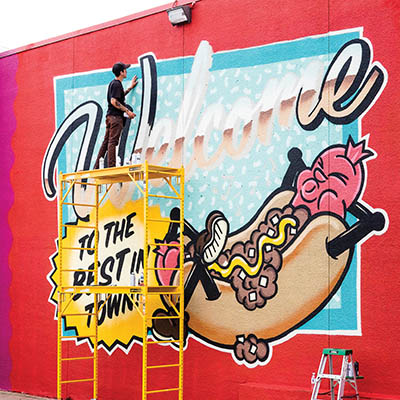Get a little weirder
In its second year, Habit Mural Festival will cover the Gateway Building in new art
Photos by Holly Peevyhouse
On May 13–14, the second annual Habit Mural Festival will bring 18 artists from as far away as Los Angeles and as close as Brady Heights to the Gateway Building, a warehouse at 856 E. 1st St., just off the highway on the outskirts of the East Village.
The artists—big names like Donald “Scribe” Ross and Adam “Codak” Smith (currently a Tulsa Artist Fellow) and locals like Jake Beeson and Chris Sker—will paint live all day, both days. On Sunday, First Street Flea will happen just inside the building, along with screen printers from Flash Flood Print Studios from 9 a.m. – 4 p.m. Andolini’s food truck will be standing by from 11 a.m – 3 p.m.
On both Saturday and Sunday, Scribe will be painting a mural in the alley at 11 E. M.B. Brady St. in the Brady Arts District.
The artists will sweat. They’ll teeter on ladders while juggling brushes and spray paint. They’ll transform a building that was once nearly invisible into color and pattern and energy—all with the knowledge that their art could be gone tomorrow.
“You can put something up on the wall and the next day you could have someone come paint a big weed leaf over it,” said Aaron Whisner, who started Habit last year. “All these artists come from that background. The temporality of the whole thing is what appeals to them. That’s just part of it. How this artwork interacts with daily life. Even over time, this stuff isn’t going to last. A piece could fade in a couple of years. That’s just the nature of it.
 “A lot of these guys have backgrounds in graffiti and skating and stuff,” he continued. “The mentality is more short-sighted. ‘This is what I’m doing today; if it gets messed up it doesn’t matter.’”
“A lot of these guys have backgrounds in graffiti and skating and stuff,” he continued. “The mentality is more short-sighted. ‘This is what I’m doing today; if it gets messed up it doesn’t matter.’”
Whisner said that commitment to painting no matter what is where the festival’s name originated.
“For a lot of these artists, this is like a habitual thing we do. Only recently has it started to explode with all the festivals happening.”
Whisner had the idea for Habit a couple of years ago, when his Clean Hands Army painted a mural on the side of The Mayo parking garage for the Tulsa Office of Film, Music, Arts and Culture. He was amazed by the number of people who came out to watch them paint.
“Before that, I thought it’d be cool to do a mural festival in Tulsa, since they’ve become popular in other cities in the past four or five years,” he said.
Vancouver, Houston, Montreal, and even Ft. Smith, Arkansas, have bustling festivals every year, with thousands coming to check out the live painting and the staggering final products.
Seeing the crowd at the Tulsa FMAC event solidified Whisner’s idea that Tulsa could also have a vibrant mural festival. But, getting permission and donated space was slow-going.
Mary Beth Babcock, one of Oklahoma’s most prominent supporters of public art, asked developer Michael Sager to help bring Whisner’s dream to life.
“How about a 60,000-square-foot building?” Sager replied.
“Sager was just moving into the warehouse where we’re doing the festival now and said we could paint the whole thing,” Whisner said. “So instead of trying to find a bunch of different walls all over, we ended up making that the main focal point.”
Whisner described the building as so nondescript that people would just drive by without noticing it.
“Now there are always people pulling over to take photos.”
Street art turns heads. And it has a way of turning things around—not just for buildings, but for people.
For Whisner, it started with a little shop called Thing One on the old Brookside strip. It sold graffiti magazines and records and markers. Whisner—a high school kid in this quiet corner of the Midwest—was smitten.
“This was before the Internet,” he said, “so this opened my eyes to a whole different art world. I was already into art, but graffiti and hip hop culture were things I didn’t have much exposure to.”
He embraced the street art aesthetic and culture and went on to become a noted Tulsa graffiti artist working under the tag “awhiz.” He founded the brand Clean Hands, painted the Woody Guthrie mural just south of Guthrie Green, and last year, launched Habit.
His work has made graffiti art as accessible for others as Thing One made it for him. For Sarah Sullivan, a textile artist and painter, it was the old Clean Hands shop in the Pearl District that lit her up.
“I was obsessed with that little shop,” she said. “Tulsa has limited retail in general—especially in street style culture. And it had art supplies. So I was there a lot.”
Under the name Sullystring, she’ll paint her first-ever mural for Habit this year, and is excited to see street art in Tulsa become more diverse.
“That’s partly why I wanted to do this,” she said. “Justin Baney, who works with Aaron, broke that barrier for me by saying, ‘We want people to do this who either haven’t done it before or it’s not their usual medium. We want to get a little weirder with who’s doing the art.’ I was like, well, I fit both of those categories!”
Sullivan has a background in graphic design but found her way to weaving and small-scale works on canvas. Her canvas for Habit, in contrast, is a 10’ x 40’ wall, one she can’t exactly turn upside down or sideways halfway through, the way she does in her smaller work.
Moreover, she laughed, “I’m not a sketcher or planner. Everything I do, especially with painting, I’m 100 percent winging it. I can’t do that entirely with this because it’s a one-take situation.”
Sullivan relishes being pushed into unfamiliar artistic territory and said that in addition to the catharsis of translating her work onto a giant scale, the visibility the festival provides is exciting.
Longtime Oklahoma graffiti and mural artist Sker agrees.
“Habit can play a valuable role in helping to shape a positive image of street art in the eyes of the public,” Sker said. “Most people only see graffiti or street art very rarely, and usually only in passing. Habit allows the artists to take their time and focus their energy on creating some truly high-quality pieces, so the public is the ultimate winner here.”
 “I firmly believe in public art,” Whisner said. “The cities you love and visit and feel like something is going on are usually cities that support this type of work and have a thriving street art community. For me the festival is a way to help people see this type of artwork up close without just having to see it on the Internet or on a family vacation.”
“I firmly believe in public art,” Whisner said. “The cities you love and visit and feel like something is going on are usually cities that support this type of work and have a thriving street art community. For me the festival is a way to help people see this type of artwork up close without just having to see it on the Internet or on a family vacation.”
Whisner doesn’t have a long-term vision for Habit, but thinks that with enough support it could grow into an event that makes Tulsa a street art destination like Montreal or Houston.
“It all boils down to the people with the wall space understanding that we can’t really do it without … walls,” he laughed. “I would love to have locations all over the place, but it takes more than just our willingness to organize it. You’ve got to have everyone in the community behind it.”
Street art is part of the landscape and the life of a community the moment it goes up. By bringing life and color to desolate places it shakes up people’s perspectives and brings them together around something vivid and unexpected. Murals like these—especially when painted live in front of the very citizens who’ll coexist with them day in and day out—can strengthen the feeling that a place is really thriving.
In the city Forbes recently named as the best place for young entrepreneurs, that’s a feeling worth cultivating.
For more from Alicia, read her article on Tulsa Ballet II’s Emerging Choreographers Showcase.


.jpg)
.jpg)
